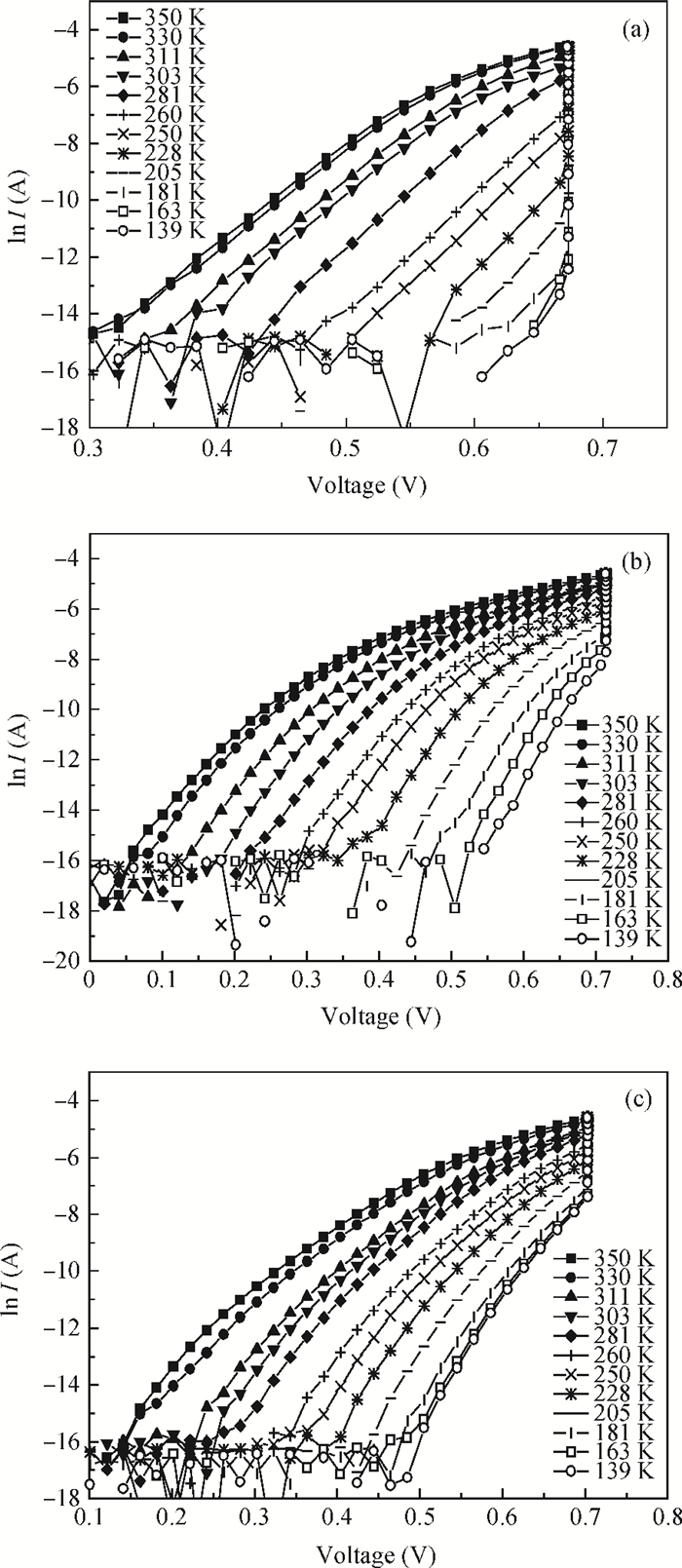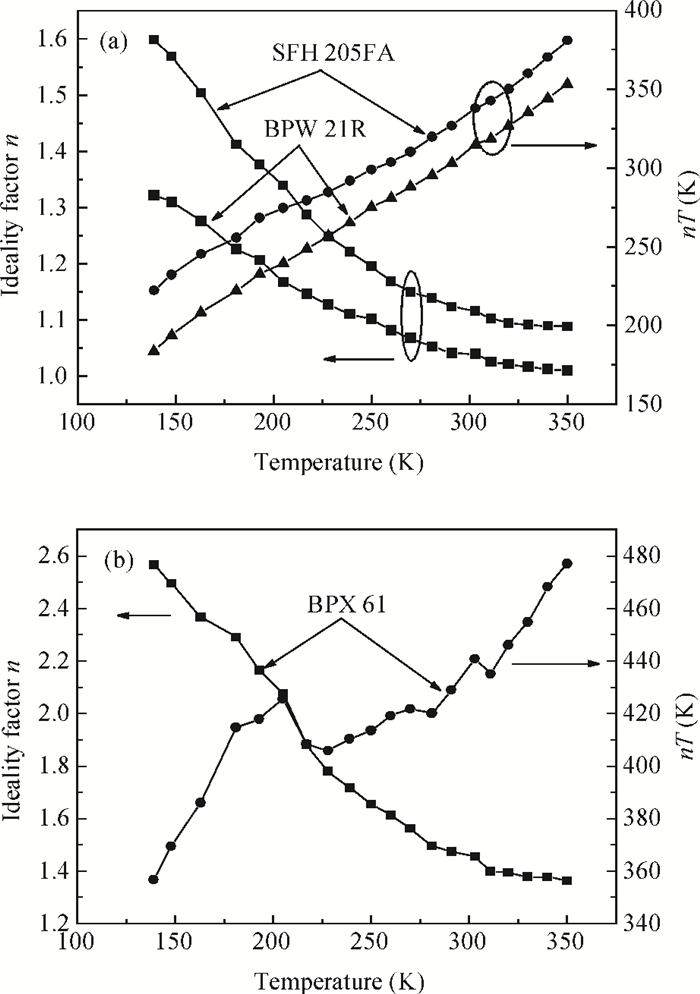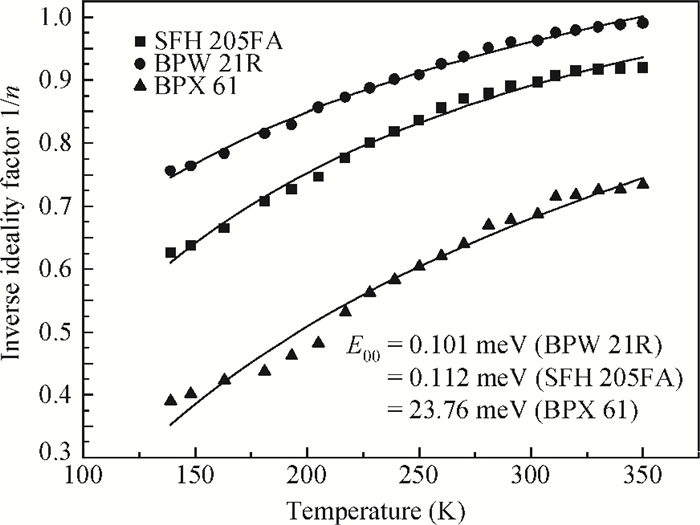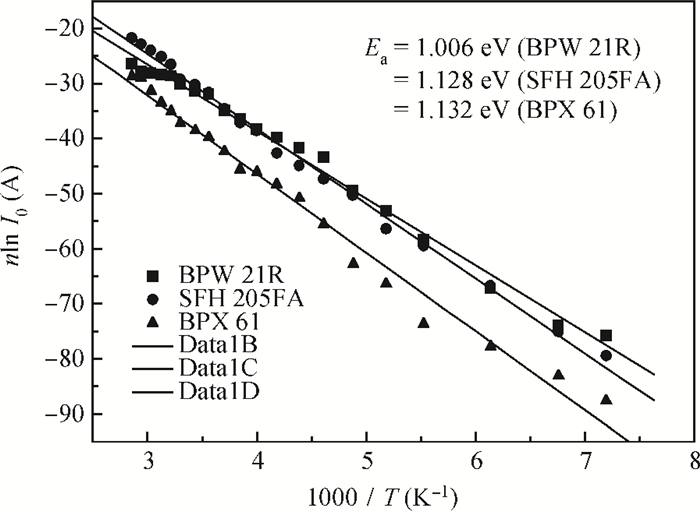| Citation: |
P. Dalapati, N.B. Manik, A.N. Basu. Influence of temperature on tunneling-enhanced recombination in Si based p-i-n photodiodes[J]. Journal of Semiconductors, 2014, 35(8): 082001. doi: 10.1088/1674-4926/35/8/082001
****
P. Dalapati, N.B. Manik, A.N. Basu. Influence of temperature on tunneling-enhanced recombination in Si based p-i-n photodiodes[J]. J. Semicond., 2014, 35(8): 082001. doi: 10.1088/1674-4926/35/8/082001.
|
Influence of temperature on tunneling-enhanced recombination in Si based p-i-n photodiodes
DOI: 10.1088/1674-4926/35/8/082001
More Information
-
Abstract
We investigate the dominant dark current transport mechanism in Si based p-i-n photodiodes, namely, BPW 21R, SFH 205FA and BPX 61 photodiodes in the temperature range of 350 to 139 K. The forward current-voltage characteristics of these photodiodes are explained via the tunneling enhanced recombination model, which gives a quantitative description of the electronic mechanism in the p-i-n junction photodiodes. The observed temperature dependence of the saturation current and the diode ideality factor of these devices agree well with theoretical predictions; the analysis also indicates the importance of doping for enhancement of tunneling. The present study will be helpful in applying the devices at low temperature ambience. -
References
[1] Manik N B, Basu A N, Mukherjee S C. Characterisation of the photodetector and light emitting diode at above liquid nitrogen temperature. Cryogenics, 2000, 40:341 doi: 10.1016/S0011-2275(00)00036-9[2] Dalapati P, Manik N B, Basu A N. Effect of temperature on the intensity and carrier lifetime of an AlGaAs based red light emitting diode. Journal of Semiconductors, 2013, 34:092001 doi: 10.1088/1674-4926/34/9/092001[3] Ngoepe P N M, Meyer W E, Diale M, et al. Optoelectronic characterization of Au/Ni/n-AlGaN photodiodes after annealing at different temperatures. Physica B, 2012, 407:1628 doi: 10.1016/j.physb.2011.09.102[4] Bayhan H, Ozden S. Forward and reverse current-voltage-temperature characteristics of a typical BPW34 photodiode. Solid-State Electron, 2006, 50:1563 doi: 10.1016/j.sse.2006.08.015[5] Chand S, Kumar J. On the existence of a distribution of barrier heights in Pd2Si/Si Schottky diodes. J Appl Phys, 1996, 80:288 doi: 10.1063/1.362818[6] Jensen N, Rau U, Hausner R M, et al. Recombination mechanisms in amorphous silicon crystalline silicon heterojunction solar cells. J Appl Phys, 2000, 87:2639 doi: 10.1063/1.372230[7] Bayhan H. Tunneling-enhanced recombination in polycrystalline CdS/CdTe solar cells. Turk J Phys, 2006, 30:109 http://adsabs.harvard.edu/abs/2006TJPh...30..109B[8] Nadenau V, Rau U, Jasenek A, et al. Electronic properties of CuGaSe2-based heterojunction solar cells. Part Ⅰ. Transport analysis. J Appl Phys, 2000, 87:584 doi: 10.1063/1.371903[9] Lin Y J. Application of the thermionic field emission model in the study of a Schottky barrier of Ni on p-GaN from current-voltage measurements. Appl Phys Lett, 2005, 86:122109 doi: 10.1063/1.1890476[10] Cheng C J, Zhang X F, Lu Z X, et al. Temperature dependence on current-voltage characteristics of Ni/Au-Al0.45Ga0.55N Schottky photodiode. Appl Phys Lett, 2008, 92:103505 doi: 10.1063/1.2896298[11] Yu L S, Liu Q Z, Xing Q J, et al. The role of the tunneling component in the current-voltage characteristics of metal-GaN Schottky diodes. J Appl Phys, 1998, 84:2099 doi: 10.1063/1.368270[12] [13] [14] Chakrabarti P, Gawarikar A, Mehta V, et al. Effect of trap-assisted tunneling (TAT) on the performance of homojunction mid-infrared photodetectors based on InAsSb. J Microw Optoelectron, 2006, 5:1 https://www.researchgate.net/publication/237451707_Effect_of_Trap-assisted_Tunneling_TAT_on_the_Performance_of_Homojunction_Mid-Infrared_Photodetectors_based_on_InAsSb[15] Hu S, Han P, Wang S, et al. Improved photoresponse characteristics in Se-doped Si photodiodes fabricated using picosecond pulsed laser mixing. Semicond Sci Technol, 2012, 27:1020021 http://adsabs.harvard.edu/cgi-bin/nph-data_query?bibcode=2012SeScT..27j2002H&db_key=PHY&link_type=ABSTRACT -
Proportional views






 DownLoad:
DownLoad:


















